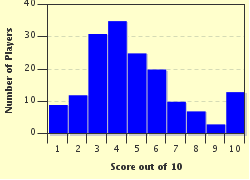Quiz Answer Key and Fun Facts
1. The stomach produces acids that could digest it. Why doesn't this happen?
2. We all have a scar on our heart that we received at birth. What is it called?
3. What is the mental protuberance?
4. Which man, from medieval times, is considered the founder of the modern science of anatomy?
5. Which of the following are the fastest long distance runners?
6. What is the common name for C-1, the vertebra at the top of the spinal column, on which our head rests?
7. The spleen is part of what system?
8. The exit of the optic nerve from the eye causes what?
9. Our two lungs are the same size and shape.
10. Which bone is also called the "innominate"?
Source: Author
russalka
This quiz was reviewed by FunTrivia editor
rossian before going online.
Any errors found in FunTrivia content are routinely corrected through our feedback system.


